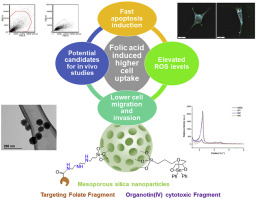Microporous and Mesoporous Materials ( IF 4.8 ) Pub Date : 2020-03-09 , DOI: 10.1016/j.micromeso.2020.110154 Diana Díaz-García , Lucia Sommerova , Andrea Martisova , Hana Skoupilova , Sanjiv Prashar , Tomas Vaculovic , Viktor Kanicky , Isabel del Hierro , Roman Hrstka , Santiago Gómez-Ruiz

|
Mesoporous silica nanoparticles (MSN) have been functionalized with the polyamino ligand N1-(3-trimethoxysilylpropyl)diethylenetriamine to give the material MSN-DETATMS (M1). The reaction of M1 with the diphenyltin(IV) compound Sn1 [obtained previously from the reaction of (3-glycidyloxypropyl)trimethoxysilane and diphenyltin(IV) dichloride in the presence of two equivalents of sodium hydroxide] in a quantity to obtain a theoretical 10% wt Sn/SiO2, gave the material MSN-DETATMS-O2-SnPh2 (M2). Alternatively, M1 was reacted with folic acid to achieve the incorporation of the folate fragment via formation of an amido bond MSN-DETATMS-FA (M3) and subsequently with Sn1 to give the tin-functionalized material MSN-DETATMS-FA-O2-SnPh2 (M4). M1‒M4 have been characterized by several methods such as infrared spectroscopy (FT-IR), powder X-ray diffraction (XRD), X-ray fluorescence (XRF), solid-state NMR spectroscopy, nitrogen adsorption-desorption isotherms, electrochemical methods, scanning electron microscopy (SEM) and transmission electron microscopy (TEM). All the synthesized nanomaterials have been tested in vitro against a wide variety of cancer and non-cancer cells in order to determine different aspects of their antitumour effects such as cell uptake, cell death, cell migration and cell invasion, to observe whether the incorporation of folate fragments may increase the cell uptake and selectivity towards cancer cells, thus increasing their potential applicability in future chemotherapeutic approaches.
中文翻译:

用二烷氧化物二有机锡(IV)化合物功能化的中孔二氧化硅纳米粒子:寻找针对癌细胞的更具选择性的系统
介孔二氧化硅纳米粒子(MSN)已用聚氨基配体N 1-(3-三甲氧基甲硅烷基丙基)二亚乙基三胺官能化,得到材料MSN-DETATMS(M1)。的反应M1与二苯基(IV)化合物的Sn1中,以获得一个理论上10%的量[从(3-缩水甘油基氧基丙基)三甲氧基硅烷和二苯基(IV)二氯化物中的氢氧化钠两个当量的存在下反应之前获得的]重量Sn / SiO 2,得到材料MSN-DETATMS-O 2 -SnPh 2(M2)。或者,M1使其与叶酸反应,通过酰胺键MSN-DETATMS-FA(M3)形成叶酸片段,然后与Sn1反应得到锡官能化材料MSN-DETATMS-FA-O 2 -SnPh 2(M4)。M1 ‒ M4已通过多种方法进行了表征,例如红外光谱(FT-IR),粉末X射线衍射(XRD),X射线荧光(XRF),固态NMR光谱,氮吸附-解吸等温线,电化学方法,扫描电子显微镜(SEM)和透射电子显微镜(TEM)。所有合成的纳米材料均经过体外测试 对抗各种癌细胞和非癌细胞,以确定其抗肿瘤作用的不同方面,例如细胞摄取,细胞死亡,细胞迁移和细胞侵袭,以观察叶酸片段的掺入是否可以增加细胞摄取和选择性对于癌细胞,因此增加了其在未来化学治疗方法中的潜在适用性。











































 京公网安备 11010802027423号
京公网安备 11010802027423号